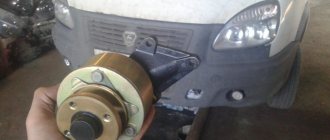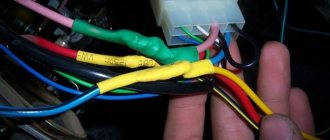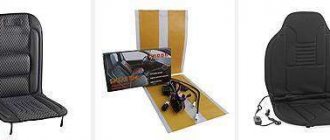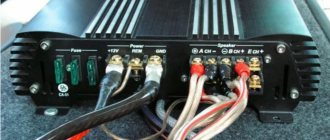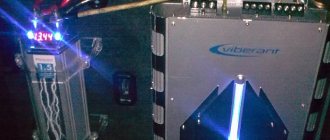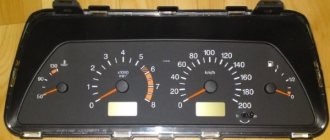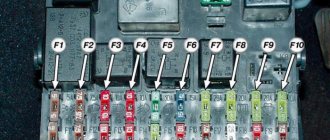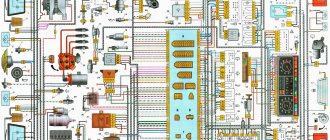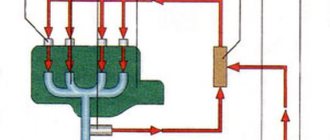Autonomous engine pre-heaters
Autonomous Hydronic pre-heaters
with a power of 4 and 5 kW are designed for installation on passenger cars and can be used for:
- preheating the engine at low temperatures for safe starting
- warming up the interior and windshield (to remove icing) when the engine is not running
- additional heating of the engine and interior when the engine is running in severe frost conditions
Hydronic heaters
are available in two versions: “compact”
Hydronic W SC
and “component”
Hydronic WS
.
The difference between them is that “compact” models are a single unit, while “component” ones consist of separate blocks. The advantage of “component” models manifests itself where the space for installing the heater
is very limited. Their blocks are smaller in size and allow them to be installed in places that are inaccessible to “compact” options.
Why do we need Hydronic?
Auto scanner smart scan tool pro: reviews, characteristics and models
This additional module, installed on a car, can warm up the coolant to operating temperature when the engine is not running. From the heated antifreeze, the engine reaches operating temperature, which allows you to immediately begin driving after starting, without wasting additional time. In addition, fuel is saved, the load on batteries (battery) and the overall wear of engine parts are reduced. Additional advantages of using Hydronic are a warmed-up interior and defrosted windows before the start of the trip.
This is an important advantage from using the device, since an acceptable interior temperature directly affects driving safety - it allows the driver to pay full attention to the road without being distracted by the cold. In addition to the function of warming up the cooling fluid regardless of the engine starting, the hydronic heater also supports the ability to “reheat” it
Operating principle and technical characteristics
Connection diagram for Hydronic to the cooling system
When the temperature reaches 70 degrees, the electronics of the Hydronic heater turns on a fan that heats the car interior.
The heater is installed in the vehicle system and for its operation consumes fuel (from 400 to 700 ml per hour of operation) and electricity (from the battery). Therefore, for its operation it is also necessary to calculate the fuel reserves and monitor the battery charge. Gidronik's operating instructions describe the following operating principle of the device: after starting the heater, fuel and air enter the combustion chamber installed in the device, where they burn and heat the coolant. Hot antifreeze is directed through a pump into the car's cooling system, where it transfers heat to the engine, as well as to the radiator of the interior heater. The system sets temperature thresholds, upon reaching which Hydronic works partially, maintaining the temperature, turns off (if the upper limit is exceeded) or turns on automatically if the liquid begins to cool. The time for a full heating cycle is approximately 40 minutes. Its performance is comparable to several boilers, but the power consumption is significantly lower, which significantly saves battery power. During startup, Hydronic uses less charge than one low beam lamp. In addition, if the battery charge is insufficient, the heater will not start working. Having examined Hydronic and the principle of operation of the device, let’s move on to studying its technical characteristics (for a passenger car model):
- The voltage used is 12 V;
- Output power when heating from 2400 to 5000 W;
- Electrical power consumption: from 23 to 50 W;
- Overall dimensions of the device – 220 x 86 x 160 mm
- Fuel consumption during operation – 0.27 – 0.62 l/hour
- Hydronic weight from 2.9 kg.
Operating principle of Hydronic
The Hydronic preheater is built into. Coolant (antifreeze) circulates through the heater and engine lines. A liquid pump, which ensures the movement of antifreeze, and a fuel pump, which supplies fuel to the combustion chamber of the heater, are mounted separately. The glow pin ignites the fuel mixture. The coolant passes through the heater. Heat from the combustion chamber through a heat exchanger heats the fluid, which is then supplied to the engine. This ensures smooth and fast heating of the entire internal combustion engine.
Hydronic liquid heater device
The built-in electric motor is powered by the car battery and can be of different power. It provides air intake from outside and supply it to the cabin. Heating of the passenger compartment begins when the fluid temperature reaches +30°C. The fan turns on automatically. Exhaust gases exit through the muffler. The liquid temperature sensor and control unit controls the combustion process.
Heater control devices
Control systems are purchased separately. There are three control options: stationary; remote; mobile. The stationary versions include an EasyStart Timer and an EasyStart Select control. The devices are installed inside the car. Easy and advanced controls, feedback, frost-resistant display and many other functions. The remote devices have two key fobs: EasyStart Remote and EasyStart Remote+, which is distinguished by the presence of a timer and display.
The operating range of the devices is 1,000 meters. EasyStart Text+ mobile application The EasyStart Text+ mobile application is available for smartphones. Communication with the device via GPS. Has all the necessary control functions. The Eberspächer company has established itself well in the market for additional heaters for cars. These are reliable and proven devices. Any driver will find a suitable heater model for his car.
Turning on the heating
Hydronic heater control panels
There are several ways to get Hydronic, the preheater, to work. The standard option is to display a button or screen with additional settings in the car interior. This is not entirely convenient, as it requires going to the car to start heating.
You can set the start by timer and the heater will heat the coolant at the specified time. This option is of course more convenient, but it may not be suitable for everyone, since you don’t always know when you need to go. An excellent solution is to install an additional Hydronic gsm module, and the heater can be controlled from the alarm key fob. If the signaling is simple, without gsm, then, for example, a system for pre-heaters is suitable, which is installed in the interior under the panel and involves the use of any convenient SIM card. Control is done by dialing a specific number on the phone, and in response you receive a complete description of the system state - from engine temperature to battery voltage. Also, all of these system startup options allow for various combinations with each other. The operating time of the Hydronic preheater is set based on the air temperature. When the thermometer readings are up to -10, the suitable operating time is from 20 to 40 minutes. If the temperature is lower, the operating time is extended to two hours. There are models of timers for Hydronic that automatically calculate the operating time of the heater - the car owner only sets the time of the intended trip.
Hydronic or Webasto heater?
Hydronic equipment is almost as popular among car enthusiasts as Webasto. Hydronic is today practically the only brand of heaters that can compete with Webasto. The Hydronic analogue is also produced using technologies developed by German engineers, employees of the Eberspacher company. The build quality of Hydronic heaters is therefore very good. However, at the same time, they discharge the battery somewhat more actively and, according to many consumers, have less reliable glow plugs. In addition, during operation these devices are quite noisy. Hydronic heaters are also a little more expensive than Webasto - 30-70 thousand rubles.
Binar or Hydronic, Webasto or Binar - which is better?
Installation of the Binar heater under the right wheel bumper.
Russian developers of heaters are undoubtedly making progress, creating equipment that better meets the requirements of car owners than the first samples - the range of settings for heating systems is expanding; The heaters already have a modular structure that allows you to expand the capabilities of controlling the device remotely by purchasing and installing additional equipment. But for now, at least according to reviews from companies that install heaters, claims on warranty issues are more often associated with Binar installations.
The main disadvantage of the Binar heater is the faster discharge of the battery. However, this is more than compensated for by the low cost of the Binar heater.
The biggest disadvantage of the Binar heater at the moment is the larger size and weight of the boiler itself than its “big brothers”. Another disadvantage noted by the owners is that the battery discharges faster than when warming up with Webasto. But Binar also has undoubted advantages:
- possibility of installing the boiler in different positions; ease of rebooting the controller when it is blocked as a result of failed launches; the control panel display does not freeze, like on Webasto; the remote control display shows the coolant temperature value, which makes it possible to control the heating - this is not available on imported analogues; significantly lower cost of the device and spare parts; the possibility of installing another coolant pump and “registering” its data in the memory of the control unit.
In conclusion, we can only advise you to study the reviews of the owners of a specific heater model, preferably those you know personally. Studying the characteristics of devices from documents will not give such a comprehensive answer as checking them in practice.
Source
Why do we need Hydronic?
This additional module, installed on a car, can warm up the coolant to operating temperature when the engine is not running. From the heated antifreeze, the engine reaches operating temperature, which allows you to immediately begin driving after starting, without wasting additional time. In addition, fuel is saved, the load on batteries (battery) and the overall wear of engine parts are reduced. Additional advantages of using Hydronic are a warmed-up interior and defrosted windows before the start of the trip.
This is an important advantage from using the device, since an acceptable interior temperature directly affects driving safety - it allows the driver to pay full attention to the road without being distracted by the cold. In addition to the function of warming up the cooling fluid regardless of the engine starting, the hydronic heater also supports the ability to “reheat” it
Technical characteristics of Hydronic heaters
| Specifications | Model | |
| Hydronic B4/D4 | Hydronic B5/D5 | |
| Rated supply voltage, V | 12 | 12 |
| Fuel used |
The differences between Webasto and Hydronic for the buyer come down to ease of choice, availability in pricing, ease of installation and availability of service centers and maintainability (simplicity and low cost of maintenance after the end of the warranty). In principle, this applies to all heaters; the same characteristics can be compared to Webasto and Planar.
What differences do they have? Webasto and hydronic, by the way, it is more correct to speak not about hydronic, but about Eberspächer (and if absolutely correct, then from the words of the German Eberspächer). There are a lot of hissing sounds in the German language, and it is more correct to pronounce the combination of letters this way - Eberspächer, why our representative office in Russia is called Eberspächer is still a mystery to me, but oh well, they know better.
So let's look at the first point in order - this is the simplicity of choice. Here the Webasto company comes first. They have only 2 types of boilers for passenger models, which differ in power 4 and 5 kW, respectively. Hydronic (Eberspächer) has a more difficult time with this, go to some website and try to choose: there are 6 types of boilers, namely spaced and non-spaced boilers (standard and Compact) and there is also the Comfort series. Further, each also contains 4 and 5 kW heaters. Of course, you can work with this and choose what you need, but most often you can’t do it without consultation. Or there is another option to spend several hours surfing the Internet and understanding the installation difficulties and features of these heaters.
Of course, let’s simplify this task, how do hydronic boilers differ from each other:
- Compact with the designation “C” at the end - for this heater, the pump that pumps liquid in the cooling system (antifreeze) and the fuel pump are located in the heater block (in the gasoline version, the fuel pump is separate due to the possibility of airing the fuel pipe when elevated temperature), this simplifies the design of the heater itself and makes installation easier. There is no need to figure out what to attach where.
- Standard, designation (for example B5W S) - for this heater, the circulation and fuel pumps for coolant and fuel are supplied separately from the unit. This allows this heater to be used in the narrowest and most cramped areas of the engine compartment of cars. Webasto has now followed exactly the same pattern.
- Comfort is a noteworthy heater - it can be set to pre-heat the car's interior and then warm up the engine. You come and sit in a warm interior, by this time the windows in the car are already warmed up and the snow is melting off the windshield, so you just need to brush it off with the windshield wipers. It can also be configured to warm up the engine faster, that is, you will have the reverse process, first of all the engine and then the interior. Its cost is also higher than the cost of a conventional heater.
This is how we smoothly approached the comparison of prices for heaters:
What it is
Let's start with a simple definition of the concept of a Hydronic preheater.
This is a special autonomous system designed to warm up the vehicle before starting the engine itself. Not only the engine, but also the interior can heat the device to create optimal temperature conditions. By carrying out pre-start preparation of the power plant, it is possible not only to reduce the rate of wear of engine components, but also to have a positive effect on reducing fuel consumption. The interior heating function creates the necessary level of comfort for the driver and passengers of his car.
If we talk about what a Hydronic installed in a car is, it can be described as a mini-engine. It replaces the engine of the car itself, performing warm-up functions. Heaters are used when car owners themselves are still sitting at home, having breakfast, solving some household issues, but intend to get behind the wheel in the near future and go on business.
Hydronic is capable of heating the power plant itself, providing a comfortable temperature inside the cabin, and defrosting the windshield wipers and windshield.
Hydronic is manufactured by a company from Germany with the rather complex name Eberspacher. Perhaps it is precisely because of the difficulty of pronunciation that people mostly hear the name of the model range of manufactured preheaters.
Some will be interested to know that this German company actually started out with completely different products. After its founding, which dates back to 1865, the company specialized in metal frames intended for glazing roofs. Already as a result of its long existence, modernization of production and repurposing, the manufacturer switched to the creation of pre-heaters, as well as a wide range of other devices.
An important feature of Hydronic is not only that it warms up the engine and the interior of the car. The device is also capable of performing a reheating function.
That is, the device provides support to the engine, helping it reach optimal temperature levels in a shorter period of time.
The device operates remotely. Using a special remote control, you can start the heater from a certain distance. This allows you not to leave your apartment or house to start the warming up process. Usually, drivers simply look out of a window or from a balcony, press a button and Hydronic starts working.
Types of Hydronic Eberspacher preheaters
The Eberspächer company presents a wide range of Hydronic preheaters for different types of vehicles. All models can be divided into four groups, which differ in power. Models with the designation “B” are gasoline, those with the designation “D” are diesel.
- Hydronic liquid heaters 4 kW.
This group is represented by four models of heaters. They are designed to warm up engines up to 2 liters. The units are small in size and weight (2 kg) and are suitable for gasoline and diesel engines.
Hydronic S3 B5 (Petrol) and Hydronic S3 D5 (Diesel). The models are new products of the company. Economical, with low noise and fuel consumption. The buyer receives 3 years of warranty service. Required voltage 12V. Power – 4 kW. Fuel consumption – 0.57 l/hour.
Hydronic S3 B5 (Petrol) and Hydronic S3 D5 (Diesel)
Hydronic B4W SC/S (Gasoline) and Hydronic D4W SC/S (Diesel). Also economical models with different levels of power consumption depending on the level of operation. Fuel consumption from 0.2 l/hour to 0.6 l/hour. Weight – up to 3 kg.
- Liquid heaters 5 kW.
This group also includes economical heaters for small cars. Power supply – 12V. Maximum power – 5-5.2 kW. Heaters can operate in three modes: low, medium and high. Each mode has its own fuel consumption and power consumption. Fuel consumption ranges from 0.32 l/h to 0.72 l/h.
- Medium class liquid heaters 10-12 kW.
Hydronic M10
These models can be used in SUVs, heavy vehicles, buses, yachts and special equipment. The group is represented by two models Hydronic M10 and Hydronic M12 . The numbers indicate the maximum heating power in watts. The required voltage is 12/24 V. To reach full power, a 24 V supply is required. The devices operate in different heating modes. Fuel consumption – from 0.18 l/hour to 1.2-1.5 l/hour. Weight 6.2 kg.
- Large liquid heater 30-35 kW.
Hydronic L 30/35 (Diesel)
The diesel model Hydronic L 30/35 (Diesel) is used for large vehicles, trucks, buses, yachts and locomotives. This is a powerful unit with the required voltage of 24V. Fuel consumed is only diesel. Fuel consumption from 3.65 l/hour to 4.2 l/hour. Installation weight – 18 kg.
Choosing the right power
In any country, a wide variety of vehicles are used, with certain power ratings, engine displacement and other parameters. And this is an important aspect in the question of which heater from the Hydronic range should be selected and installed in your car.
The first thing you need to do is look at your engine, find out the engine size, so that the purchased pre-heater from the Hydronic series can fully cope with the task.
Hydronics are equally suitable for cars and trucks. Just what is suitable for a passenger car is unlikely to satisfy the needs of a truck. Conversely, there is no need to install Hydronic, which is designed for trucks, on a passenger car. Sometimes this is even impossible due to the large dimensions of the device.
All Hydronics produced by the German company are divided according to power indicators, which directly affects the volume of the heated area and the heating rate of the special liquid circulating through the cooling system. As a result, we can select Hydronics with parameters from 4 to 35 Volts. It is in Volts that the power of the preheater is determined.
Now let’s take a more specific look at the engine parameters and their volume to select the optimal heater model.
- For passenger car engines with a volume of no more than 2.2 liters, it will be enough to use the simplest Hydronic 4 models. Excellent price-performance ratio. Such devices consume a minimum amount of fuel, which is enough to fully preheat the engine and heat the cabin before boarding the driver and his passengers.
- For power units installed on passenger cars with a volume of 2.2-5.5 liters, more powerful 5 Volt models, that is, Hydronic 5, are suitable. They perfectly perform their tasks, efficiently consuming fuel and performing their functions efficiently.
- Minibuses and huge SUVs can benefit from the capabilities of Hydronic 10. These are already quite powerful models that passenger cars do not need.
- Hydronics for 24, 30 and 35 Volts are considered the most powerful. They are designed specifically for large passenger buses, trucks, vans, tractors and other heavy equipment. Their capabilities are enough to warm up impressive volumes of cooling liquid, as well as spacious interiors, like in passenger buses.
Remember one important pattern. The higher the power, the larger the size of the device for preheating the engine and warming up the interior. Be sure to take this point into account, since a too massive Hydronic simply may not fit in the engine compartment of your car during installation. And this will become a problem.
Comparison of prices for Webasto and Hydronic (Webasto and Hydronic)
A few years ago, the cost of Webasto and Hydronic really differed by a good amount. It was more profitable to install Hydronic (Eberspaecher); it was cheaper, somewhere between 5-10 thousand rubles. Now the price limit has been erased, and you can buy Webasto at the same cost as Hydronic, and even more often cheaper. This is if we are talking about retail prices. But the price range for hydronics is still high and they can offer it to you at a good discount. I also want to note that the cost of Webasto is fixed in all regions of the country, although of course there are some companies that sell it cheaper. The cost of installing heaters is the same. and is about 6-12 thousand rubles, depending on the complexity of the installation.
Thus, Eberspächer's achievements due to the cheaper cost of the heater are lost. Although the controls for this heater are still cheaper, the Eberspacher heater can also be connected to an additional alarm channel, without voiding the warranty. That is, you can already save at least 5,000 rubles. And if you want to start the heater from your mobile phone, then your savings will be 12,000 rubles, which is noticeable, right?
These are the different heaters: on the left is the “C” version, where the fuel and circulation pump are in one housing, on the right is the regular heater model,
Hydronic starts but stalls after a minute
Diagnostics of the Hydronic heater
This is usually caused by:
- the formation of air jams in the cooling system, as a result of which the temperature sensors of the device overheat, and the control unit turns off the fuel supply;
- low quality coolant;
- disruption of fuel supply to the heater burner. In addition to disruption (clogging) of the fuel wire and breakdown of the metering pump, this can be caused by low quality fuel and excessive contamination of the fuel tank. Diesel Hydronic does not start in cold weather due to gelation in diesel fuel, so it is recommended to install fuel heating.
Overview of preheaters
The mentioned equipment is produced by the German companies Webasto Gruppe and Eberspächer Climate Control Systems. The products of both manufacturers are distinguished by operational reliability, quality of components and assembly. Products from the Teplostar, Binar, ELTRA-Thermo and other companies are also quite widely represented in this market segment.
Webasto pre-heaters for passenger cars
represented by a line of three models:
- “E”
- for passenger cars with engine capacity up to 2000 cm3. - “C”
- for a car with a power unit from 2200 cm3. - “P”
- for SUVs, minibuses, minivans and luxury cars.
The advantages of this heater include the presence of an automatic programmable timer and a remote control in the form of a key fob. Modifications are available for gasoline and diesel engines with different technical characteristics.
The devices also have a number of disadvantages: the liquid crystal screen freezes at low temperatures, the high cost of equipment and components.
Products of the Hydronic brand from the German corporation Eberspächer are in great demand in our country. The product range includes five modifications of two series:
- Hydronic 4
- for vehicles with a displacement of up to 2.0 liters. - Hydronic 5
– for cars with engines over 2000 cm3. - Hydronic MII
– for equipping trucks and special equipment with diesel power units from 5.5 to 15 liters. - Hydronic II Comfort
– modification for cars with engines from 2 liters. - Hydronic LII
- for trucks and special vehicles with a power unit displacement of 15 liters or more.
The listed models can be used to heat engines and the interior.
Their main advantages over analogues are: low fuel consumption and the presence of a built-in self-diagnosis system.
However, the equipment has a number of features, in particular, frequent clogging of the glow plug is noted, the replacement of which is not covered by warranty.
Scope of application and installation
What is an arrow
Option for installing Hydronic in the engine compartment
It is designed for different types of transport - from small compact cars to trucks and buses. For this purpose, heater options are available with different heating powers, so the ideal choice depends on the engine size, and, consequently, the volume of coolant.
For an engine whose volume does not exceed 2.2 liters, the ideal option would be to install the hydronic model - 4. Volume from 2.3 to 5.5 liters requires the installation of hydronic - 5. Models numbered 10 are suitable for engines from 5.5 up to 15 liters, and 24-35 are suitable for large volumes of coolant and are installed on buses and trucks. By the way, about the sizes. In this regard, the latest Eberspächer Hydronic models have a big advantage, since their design consists of several elements and the pump is made separately. This positive feature allows you to place the preheater in the engine compartment of almost any car. Installation locations can vary significantly depending on the model and brand of machine:
- Behind the bumper (heater manufacturers recommend);
- In the engine compartment;
- In the wheel well;
- On the bottom of the car.
Since the coolant heater is a technically complex device that is connected to all operating systems of the car, it is better to entrust the installation of Hydronic to professionals. In addition, its installation requires special tools. The statistics of car damage due to incorrect installation of the heater is amazing - almost 80% of accidents or equipment breakdowns occur precisely for this reason. Installation of equipment by specialists will cost from 8 to 15 thousand rubles, but will allow you to protect yourself and your car. Also, do not violate the operating conditions of the equipment - repairs are carried out only in specialized service centers and are quite expensive. Well, we looked at what Hydronic is in a car, its operating principle and features. In conclusion, I would like to remind you that pre-heaters consume electricity for their operation, so you must monitor the condition of the battery and follow the rule - the operating time of Hydronic should not exceed the time the vehicle is moving.
Other preheater comparisons
If this comparison does not satisfy your curiosity, then you can also find many others on PartReview.
For example, comparisons of Eberspacher preheaters with such companies as: Severs, Binar, Defa, Longfey, Teplostar, Alliance, Start-M, Atlant.
Comparisons of Webasto pre-heaters with such companies as: Severs, Binar, Defa, Longfey, Teplostar, Start-M, Alliance, Atlant are also available.
In addition, you can find out who is better among other manufacturers of preheaters: Severs or Webasto, Binar or Webasto, Binar or Severs, Defa or Webasto, Longfei or Webasto.
